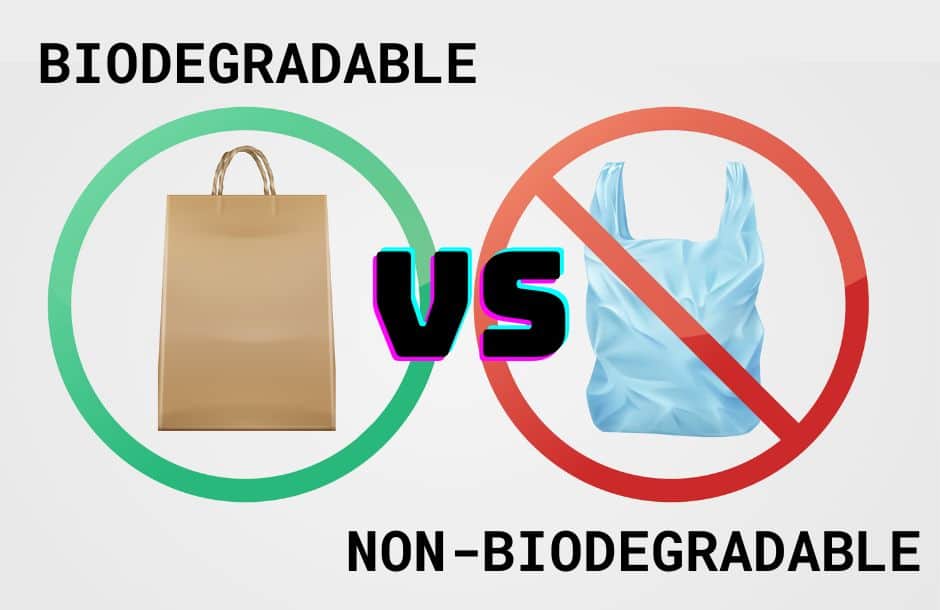In a world where we are constantly being urged to reduce our carbon footprint and live a more eco-friendly lifestyle, it’s important to know the difference between biodegradable and non-biodegradable materials.
Biodegradable materials are those that can be broken down by natural processes into simpler, organic materials. This means that they are not harmful to the environment and will not build up in landfills.
Non-biodegradable materials, on the other hand, cannot be broken down by natural processes. This means that they will remain in landfills for many years, potentially causing environmental damage.
So, which is more eco-friendly?
The answer is biodegradable materials. Not only are they better for the environment, but they also help to reduce our reliance on landfills.
Biodegradable vs Non-Biodegradable Material, which is more eco-friendly?
There are many types of materials that can be classified as biodegradable and non-biodegradable. Biodegradable materials are those that can be broken down by natural processes into simpler organic materials. Non-biodegradable materials are those that cannot be broken down by natural processes and remain unchanged over time.
So, which type of material is more eco-friendly? That depends on a number of factors, including the specific material in question, the environment in which it will be used, and the time frame involved.
In general, biodegradable materials are more eco-friendly than non-biodegradable materials because they eventually break down and return to the earth.
However, some biodegradable materials, such as plastics, can take many years to break down, and in the meantime, they can cause pollution and other environmental problems.
Non-biodegradable materials, on the other hand, will never break down and will always remain in the environment, even if they are recycled.
The most eco-friendly option is to use materials that are easily biodegradable and that will break down quickly in the environment. This way, there is no risk of pollution or other environmental problems, and the materials will eventually return to the earth.
What is Biodegradable Material?
Biodegradable materials are those that can be broken down by living organisms. This process is called biodegradation. It usually happens through the action of enzymes secreted by bacteria or other microorganisms.
The time it takes for a material to biodegrade depends on many factors, including the type of material, the amount of light, oxygen, and moisture present, and the temperature. Some materials, such as paper and food waste, can break down quickly, while others, such as cans, bottles, or styrofoams, can take centuries to degrade.
The benefits of using biodegradable materials are that they are renewable and they don’t add to the growing problem of pollution. Additionally, when biodegradable materials break down, they provide food and shelter for wildlife.
The downside of biodegradable materials is that they often cost more than non-biodegradable materials. Additionally, some biodegradable materials, such as food waste, can produce methane gas as they decompose, which is a potent greenhouse gas.
Examples of Biodegradable Materials
There are many materials that are biodegradable. This means that they can be broken down by microorganisms into simpler substances that can then be used by plants or other organisms. Some biodegradable materials include:
-Organic materials such as plant materials, food scraps, and paper
-Plastic materials made from biodegradable polymers such as polylactic acid (PLA)
-Natural fibers such as cotton, wool, and jute
-Wooden materials
Organic materials such as plant materials, food scraps, and paper are biodegradable because they are made of carbon-based compounds. These materials can be broken down by microorganisms into simpler substances like water, carbon dioxide, and methane. The water and carbon dioxide can then be used by plants, and the methane can be used by other organisms.
Plastic materials made from biodegradable polymers such as polylactic acid (PLA) are biodegradable because the polymers are made of carbon-based compounds. The polymers can be broken down by microorganisms into simpler substances like water, carbon dioxide, and methane. The water and carbon dioxide can then be used by plants, and the methane can be used by other organisms.
Natural fibers such as cotton, wool, and jute are biodegradable because the fibers are made of carbon-based compounds. The fibers can be broken down by microorganisms into simpler substances like water, carbon dioxide, and methane. The water and carbon dioxide can then be used by plants, and the methane can be used by other organisms.
Wooden materials are biodegradable because the materials are made of carbon-based compounds. The materials can be broken down by microorganisms into simpler substances like water, carbon dioxide, and methane. The water and carbon dioxide can then be used by plants, and the methane can be used by other organisms.
What is non-Biodegradable Material?
Non-biodegradable materials are materials that cannot be broken down by natural processes. This means that they will stay in the environment for a very long time, potentially forever. This can be a problem for the environment as it can lead to pollution and the build-up of waste in landfill sites.
There are many different types of non-biodegradable materials, including plastics, metals, glass and some types of fabric. These materials are all very durable, which is why they are often used in packaging and construction. However, this durability also makes them difficult to break down, meaning they can stay in the environment for centuries.
While some non-biodegradable materials can be recycled, this is not always possible or practical. For example, plastic can be recycled but it is often not cost-effective to do so. This means that many non-biodegradable materials end up in landfill sites, where they will stay for a very long time.
Non-biodegradable materials can have a negative impact on the environment, but there are some ways to reduce this. Recycling where possible is one way to reduce the amount of waste that goes to landfill. Another way is to choose biodegradable alternatives where possible, such as paper or cardboard instead of plastic.
In conclusion, non-biodegradable materials can be a problem for the environment but there are ways to reduce their impact.
Advantages of Biodegradable Material
There are many advantages of biodegradable materials. One of the most important advantages is that biodegradable material is more eco-friendly than non-biodegradable material. Biodegradable material will decompose naturally and will not pollute the environment. Non-biodegradable material, on the other hand, will take years to decompose and will release harmful chemicals into the environment.
Another advantage of biodegradable material is that it is renewable. Biodegradable material can be replenished naturally, whereas non-biodegradable material has to be mined or manufactured. This means that biodegradable material is a more sustainable option in the long run.
Biodegradable material is also often cheaper than non-biodegradable material. This is because biodegradable material can be sourced from nature, whereas non-biodegradable material has to be artificially created.
Overall, biodegradable material has many advantages over non-biodegradable material. Biodegradable material is more eco-friendly, renewable, and often cheaper. These advantages make biodegradable material a better option for many applications.
Advantages of Non-Biodegradable Material
Non-biodegradable materials have many advantages over biodegradable materials. They are more durable and last longer, which means they don’t have to be replaced as often. This reduces the amount of waste that goes into landfills and the amount of resources that are used to produce new products. Non-biodegradable materials are also usually cheaper than biodegradable materials, making them more cost-effective in the long run.
Disadvantages of Biodegradable Material
The disadvantages of biodegradable materials are that they are not always as durable as non-biodegradable materials and they can be more expensive. Biodegradable materials can also take longer to break down, which can be a problem in landfills.
Disadvantages of Non-Biodegradable Material
Non-biodegradable materials are those materials that cannot be broken down by natural processes over time. This means that they will stay in the environment for many years, potentially harming wildlife and polluting the land, air and water.
Some examples of non-biodegradable materials include plastics, metals, glass and certain chemicals. These materials are often used in packaging, construction and manufacturing. While they have many benefits, their downside is that they can take centuries to break down.
In contrast, biodegradable materials are those that can be broken down by natural processes over time. This includes materials like paper, food scraps and leaves. Biodegradable materials are a much more eco-friendly option as they will eventually break down and won’t cause pollution or harm wildlife.
So, which is more eco-friendly? Biodegradable materials are the clear winner when it comes to being eco-friendly. Not only do they eventually break down, but they also don’t cause pollution or harm wildlife in the meantime.
Want to know more about various BIODEGRADABLE products & materials?
Check out our latest articles and tips for enjoying your simple and sustainable life.

